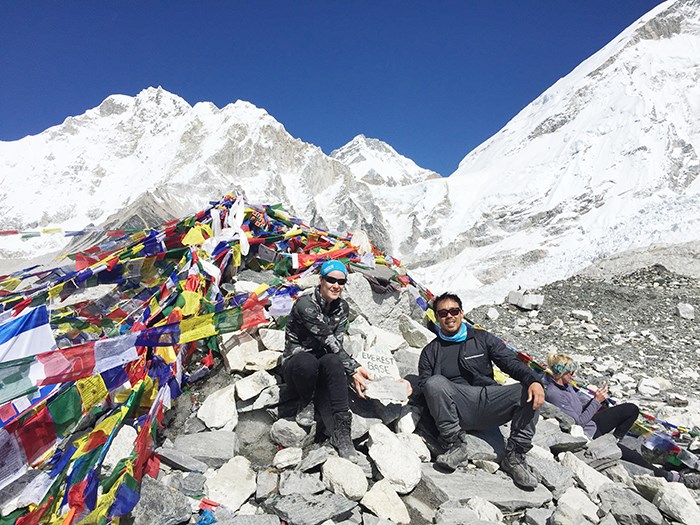A trip to a remote location at the top of the world would simply be a bucket list adventure for many. For a local couple, though, it was a chance to participate in an adventure that supports a cause – that fills water buckets, so to speak.
Maja Aro and her husband, Jeff, had gone to Mount Kilimanjaro five years earlier as part of a trip through the charity WaterAid, and in the fall the couple returned to high altitudes as part of a trek through the Himalayas.
The trip was to help raise money to rebuild the water infrastructure in areas of Nepal that were hit hard during an earthquake in April 2015 that killed approximately 9,000 people and injured another 22,000. The quake damaged much of the region’s infrastructure, including water systems, and also caused an avalanche on Mount Everest that killed 21 people.
WaterAid is now trying to help the region rebuild. Worldwide, it has the goal of ensuring everyone has access to clean water by 2030. As one of its fundraising strategies, the money the couple paid for the trip goes to support the non-profit’s efforts.
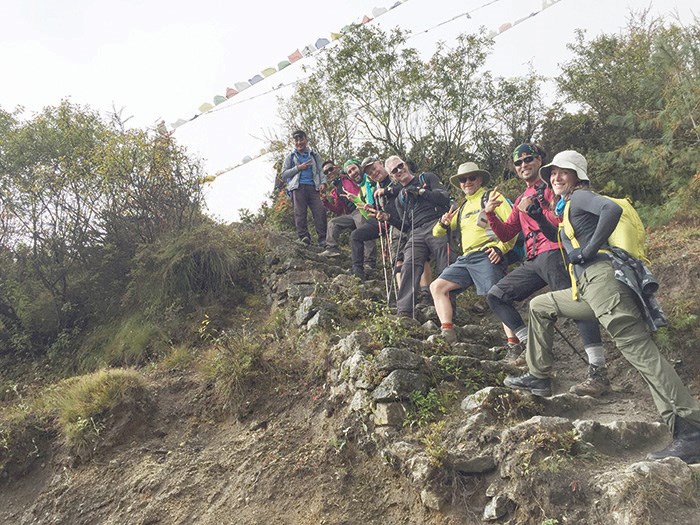
“WaterAid sets up these adventures so you can have a cultural experience,” Jeff says. “It’s funny because it’s not a sexy cause, but it’s important.”
The Aros had to make arrangements through work to make sure they could do the trip to Nepal from Oct. 4 to 28. They flew through Hong Kong, then to Katmandu in Nepal, where they spent a little time before joining the other trekkers from Canada and the U.S. Along with Katmandu, they visited the village of Nagarkot, as well as Tara Secondary School and Vidyarthi Niketan Higher Secondary School in Bhaktapur.
In these places they could see some of the damage done, though there were signs the infrastructure is being replaced.
It was also a learning experience for them. They work in stunt coordination in the film industry, but found simply learning how to cross the street in Katmandu far more dangerous.
Even the time change was a bit of a challenge.
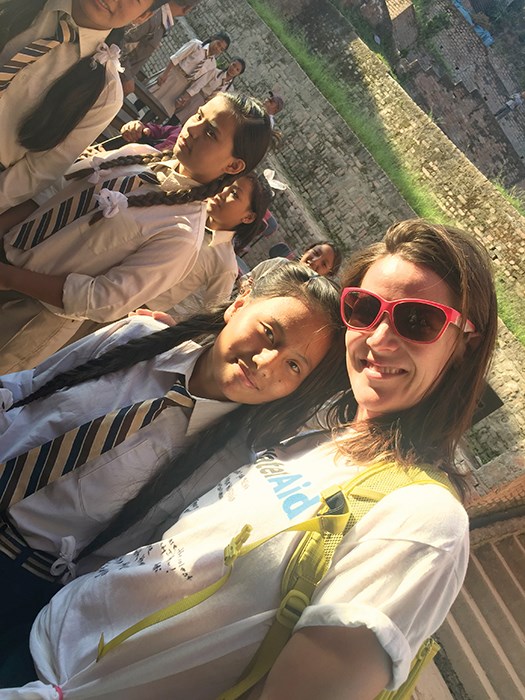
“The time difference is strange too,” Jeff says. “It’s 12 hours and 15 minutes.”
The efforts in Nepal mean fresh water and toilets for 90 homes and 400 people, all for $7,000.
The Aros, who changed their last names as a tribute to Mount Kilimanjaro by taking the last three letters, had the chance to see a couple of schools where the project was providing fountains for fresh water.
The kids have even started clubs to promote sanitation. A new addition was a rainwater collection system that uses a bio-sand filter on the roof to help provide water.
“You get to see how your money affects people,” Jeff says. “We got to see what our money was doing.”
A key part, as the Aros learned, was the importance of education about hygiene, especially in a country that has been largely rural, with many living on farms without toilet facilities. In the past, a project might simply leave behind infrastructure, but it might not be used for its intended purpose to provide safe, clean water. At the same time, helping means having to adapt to the local culture.
“It is really important to be culturally sensitive,” Maja says.
A recent example of a shift in thinking taking place was the introduction of a box in Bhaktapur to collect women’s sanitary pads, located near the girl’s washroom at school, in order for the pads to be incinerated as part of proper hygiene.
The WaterAid program aims to help for a few years to make sure a community is up and running again. As part of the project, local engineers are hired to make sure the system is sustainable.
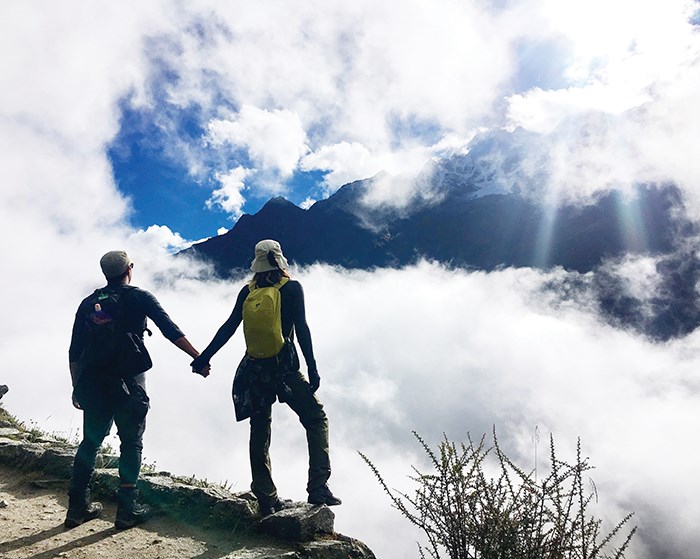
“Every community around the world they monitor for 20 years,” Maja says.
The school students were able to fill them in on what the work will mean to the community. The Aros were also touched to meet the young people and learn about their aspirations.
One noticeable characteristic of the region was the low percentage of men in the villages, as it was common to see mothers and children without the fathers around. As the Aros discovered, many of the men were away working in other countries, particular in the Middle East, to provide for their families.
At the same time, despite the hardships people face, there was a sense of peace in the country, even in the aftermath of the 2015 earthquake.
They also found the country a land of contractions where people were very warm and open, yet had a long-standing caste system with people entrenched in social strata.
“Even in Nepal, the caste system is so strong,” Maja says.
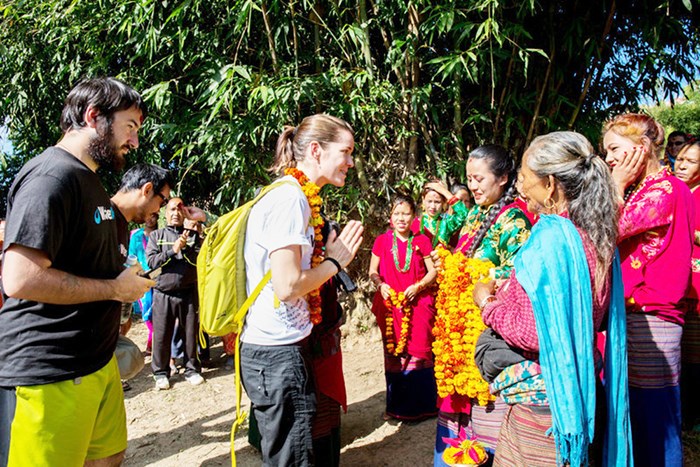
As for the trek itself, the 147-kilometre adventure took nine days just to get up to the Everest basecamp. The group began their climb at Lukla at about 2,800 metres above sea level and made their way to basecamp at 5,364 metres, where they spent one day before taking four days to get down. There were relaxed moments over cards, watching the movie Everest at one of the stops and even the occasional sporting event.
“We played volleyball with our Sherpas,” Maja says, adding they lost a few balls in the valleys below.
It often was not all easygoing, though, as Jeff fell ill for part of the trip.
“There were days that were extremely painful,” he says.
As well, they had to be conscious of items like toilet paper, which they had to bring along.
With water already at a premium in the country, the trip also meant paying a premium for a high-altitude shower powered by a propane heater. The shower made things more bearable, but they were still facing sub-zero air temperatures outside, so most of the time they used baby wipes.
Another reason having a shower was not a regular activity is because water is of the utmost importance for hikers, especially in extreme conditions like the Himalayas. They needed a way to clean the water. This they accomplished with a LifeStraw, which uses a filter to make contaminated water safe.
“Basically, you could drink out of a mud puddle,” Maja says.
One feature of the landscape that struck them on the trek was a memorial about a day below basecamp with flags and prayers written out. This had been erected in memory of everyone who had died on the mountain.
As well, the hike meant the Aros had to unplug – to simplify things and be patient rather than trying to multi-task as they do back home. Losing one’s focus meant the risk of falling off a cliff.
“It was a really good cleanse of sorts,” Jeff says.
Still, the Aros realize if they had simply decided to go on their own to make the trek, without the WaterAid connection and the opportunities to meet people in Nepalese communities, it would have felt like half the experience of what they had.
“You don’t just get a superficial tourist experience,” Jeff says.
Instead, they helped raise money and consciousness about the importance of safe water for people all over the world.
“We learned so much about what WaterAid does,” Maja says. “We learned so much about the culture.”
